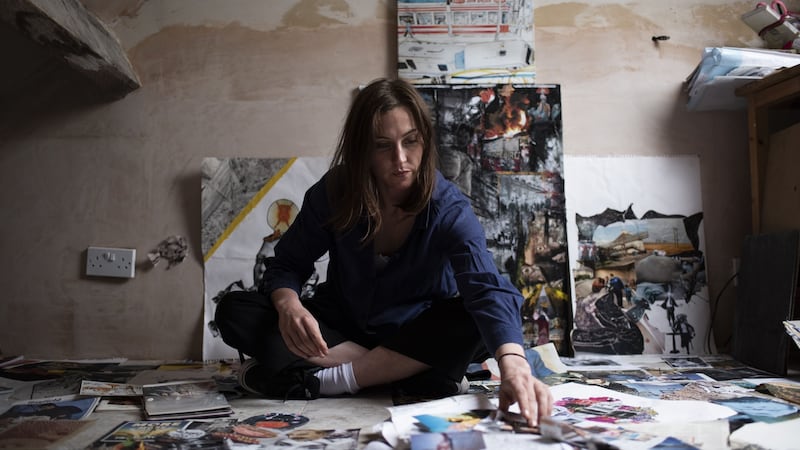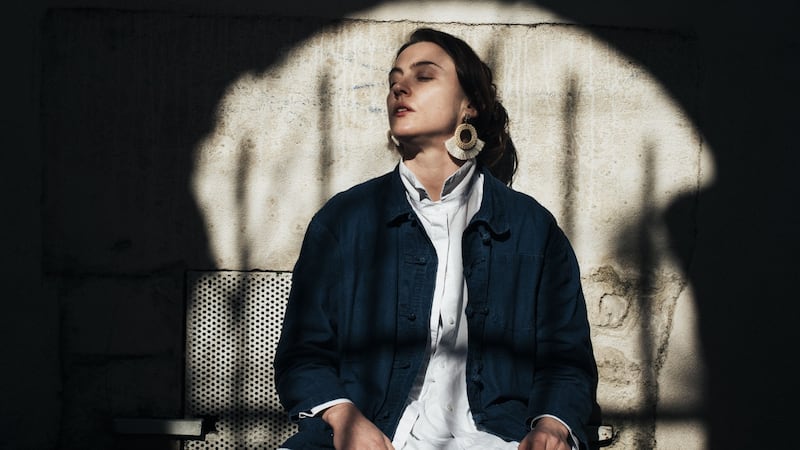Last week, at London's Dance Umbrella, Oona Doherty represented the tough exterior and vulnerability of working class men on stage. Next week in Belfast, she'll present the essence of female identity.
It might appear like nice symmetry, but that’s not how the Belfast-based choreographer works. She doesn’t assemble aesthetic themes into bullet lists and then map them into her career path. Just like her movement style as a dancer, these creative decisions are reactive, born in the moment, and emerge from deep-rooted impulses.
Doherty's breakthrough work as a choreographer was Hope Hunt and The Ascension into Lazarus. As the audience waits outside the theatre, she arrives to a screeching halt in a car, music booming from its open windows. Full of pent-up aggression, she embodies the hard-chaw exterior of the working class male, while also uncovering their inner vulnerability.
I asked myself how I could represent femininity in all of its 360-degree form. How could I show it as beautiful, fragile, ugly and strong all at the same time?
It’s a theme that she expanded in Hard to Be Soft: A Belfast Prayer, a four-part dance that included two solos, a grappling duet for two shirtless men and a group dance called Sugar Army, performed by strong, self-assured teenage girls from Derry. Sugar Army has now led to Lady Magma: The Birth of a Cult, a celebration of female strength which will receive its Irish and UK premiere on October 31.
“I’d say Lady Magma was a reaction rather than a plan,” says Doherty. “Sometimes you discover that an idea hasn’t been fully developed in a work and that leads you on to the next one.”
When she finished Hard to Be Soft she felt unsatisfied with the Sugar Army dance.
“I realised that my feminine movement was plastic, kind of stereotypically plastic. I asked myself how I could represent femininity in all of its 360-degree form. How could I show it as beautiful, fragile, ugly and strong all at the same time?”
Hope Hunt and the Ascension into Lazarus and Hard To Be Soft have established Doherty as one of the most exciting voices in contemporary dance in Ireland, a reputation now spread to Europe. Hope Hunt won her the Best Performer award at Dublin Fringe in 2016 and the Total Theatre Award and The Place Prize at Edinburgh Fringe in 2017. But being chosen as an Aerowaves artist in 2017 was a major impetus. The pan-European network chooses 20 emerging dance artists every year, who are then programmed in venues and festivals throughout Europe.
"Aerowaves lifted my career and opened up opportunities. France, in particular, has been very supportive of me," she says.
At Grenoble [re]connaisance she won the Jury Prize and Audience Prize, and also met her agent Gabrielle Veyssière. She was also appointed an associate artist at Maison de la Danse in Lyon and starred in its Biennale de la Danse last year.
“Oona is a generous artist, sincerely engaging with young dancers,” says Dominique Hervieu, director of Maison de la Danse and Biennale de la Danse. “And that’s an important quality in order to be an associate artist at Maison de la Danse. She always delivers a complete sensitivity to the subject she treats, without being politically correct. It is this freedom that really interests me.”

I'm trying to make a show that looks like the birth of a cult. A ritual takes hold. Part of you wants to join in and part of you wants to turn away
But how do dances about hard men from Belfast engage French audiences?
“The strength of her performances create a universal dimension that is understood by everybody,” says Hervieu. “The audience in Lyon fell in love with Oona. Her relationship between sensibility and technique, movement and presence, is unique.”
Lady Magma is performed by Aoife Mac Atamney, Louise Tanoto, Tilly Webber, Janie Doherty and Justine Cooper, and draws on various influences: rituals, Dionysus, female sexuality and advertisements from the 1970s. The latter include various ads for various perfumes and Cadbury’s Flake, all using female sexuality to sell a product. Doherty wants to re-own this sexuality in a neo-feminist celebration.
“Lady Magma is a shedding of these limiting images of women and beauty, a chaotic ritual clearing, and a return to the animal,” she says. “I’m trying to make a show that looks like the birth of a cult. A ritual takes hold. Part of you wants to join in and part of you wants to turn away.”
The males depicted in Hope Hunt and Hard to Be Soft are solitary, suffering in their insecurity, whereas the teenagers in Hard to Be Soft and the cast of Lady Magma seem to draw strength from each other.
“Yes, the solos have more struggle, but it’s probably because Lady Magma is a group work and there is less visible struggle. We developed it over time so relationships form and the choreography comes to reflect mutual support. But I’m not claiming that women support each other more than men, or that men struggle more or have a tighter stereotype to conform to. Everybody, in all the works, whatever gender, age, shape or personality, transcends themselves through strength and hard work.”
Lady Magma sees a return of collaborators David Holmes (sound), Ciaran Bagnall (light and set) and Luca Truffarelli (photo and film), and, whereas Hard to Be Soft was framed in an almost clinical solid white setting, Lady Magma has a rich colour palette inspired by the 1970s. There will also be chairs and cushions on stage so audience members can experience the audience up close. In particular she is keen to evoke kinetic empathy.

For me, there is another level to choreography, rather than just shape and form. Feeling is more important than aesthetic
“For sure the people close to the dancers have a different experience to the audience at the back,” she says. “I think that proximity really works.”
But how close will they get to the action? Doherty mentions kinespheres, a term coined by dance theorist Rudolf Laban to describe the sphere around your body whose periphery can be reached by extended limbs.
“When your kinespheres are almost touching then empathy sets in. Or if you can see the tears, or if you can see the lips curl into a smile. For me, there is another level to choreography, rather than just shape and form. Feeling is more important than aesthetic.”
This seating arrangement isn't a whim, but the result of research into the performance spaces of ancient Greece and Rome. Greek audiences sat surrounding the performance space, whereas in the Roman auditorium the half-circle of audience members completes the virtual half-circle of the stage. In the words of David Wiles, author of A Short History of Western Performance Space, "The Greek audience sat in judgment around the magical circle, but the Roman audience sat within it."
Like the audience witnessing the arrival of Doherty in a speeding car in Hope Hunt, she is always trying to elicit a response from audiences that, she feels, are forced to be passive in the traditional theatre setting.
“I can feel quite intimidated by the theatre,” she says. “I was recently at Wasteland by Gary Clarke, which is about the fall of the coal industry and the beginning days of the acid house culture in Thatcher’s Britain. I loved it, everyone did. But nobody moved! It is so strange to watch a dance show in stillness. I actually don’t think it is very healthy, to be honest. You should scream, shout, clap, get pissed off, move in your seat, and feel like you are able to react however you want without getting kicked out. The theatre for me a strange, silent, still place.”
We need to invest and support companies, arts centres and artists, otherwise we are at risk of letting it rot to nothing
Lady Magma was co-produced with Belfast-based Prime Cut Productions and in association with four French venues and the Belfast Festival. It was also funded by the Arts Council of Northern Ireland, Culture Ireland and the British Council. For Dominique Hervieu this level of support is essential,
“She is at an important stage in her artistic work which requires assistance from institutions in order to find her own choreographic universe,” she says.
But, looking around Ireland, Doherty despairs. “In France you have lots of theatres built solely for dance, circus, physical theatre performance. I really hope for Ireland to one day have theatres in local areas dedicated to movement and dance.”
That feels a long way off.
“Here, dance is bottom of the ladder. We need to invest and support companies, arts centres and artists, otherwise we are at risk of letting it rot to nothing. Lots of artists in Ireland basically work for free, and that’s not sustainable. We’re good. Maybe we need to get better at fighting.”

















